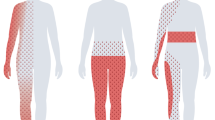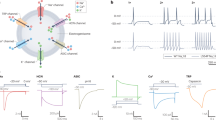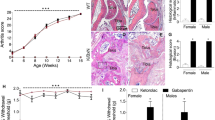Abstract
Nociceptive pain in response to peripheral noxious stimuli, and inflammatory pain resulting from tissue damage, serve as warnings that normal bodily function cannot resume until the stimulus abates or the tissue repairs. Stimuli cause numerous receptors, ion channels and other cellular machinery to respond, and propagate signals to the central nervous system, where this information is processed and perceived as pain. In healthy individuals, tissue damage results in physiologic—generally reparative—changes that lead to heightened sensory perception and, often, pain. In rheumatic diseases, the joint pain bears much in common with chronic inflammatory pain, but the underlying disease state is typically much more intricate and no reparative function is evident. Addressing the complex pains of rheumatic disease remains an ongoing challenge. Pain signaling pathways involve many molecular components that could potentially be targets for pharmacotherapeutic intervention, but the complexity of this system might also mean that multiple sites must be affected simultaneously to disrupt propagation of pain signals. In addition, to be therapeutically viable, pain drugs must be safe and not alter tactile sensory function, alertness or cognitive function. In this article we review the molecular functions in nociceptive, inflammatory and rheumatic pain pathways, and the therapeutic options they might offer.
Key Points
-
Nociceptive pain is a normal, physiological response to noxious stimuli that foretells the likelihood of tissue damage or indicates pathology
-
Numerous receptors, ion channels and signal transduction molecules convey sensory information (location, intensity and duration of the stimulus) from the periphery to the central nervous system, where the processing of these signals can result in the perception of pain
-
Despite dense innervation, healthy joints are not perceived as painful, but become subject to pain upon injury or pathology—particularly the pathology associated with rheumatic disease
-
The high numbers of known receptors and ion channels in pain suggest a wealth of novel targets for pharmacotherapy, and mechanism-based investigations are being made into manipulation of these targets
This is a preview of subscription content, access via your institution
Access options
Subscribe to this journal
Receive 12 print issues and online access
$209.00 per year
only $17.42 per issue
Buy this article
- Purchase on Springer Link
- Instant access to full article PDF
Prices may be subject to local taxes which are calculated during checkout




Similar content being viewed by others
References
Fields HL and Martin JB (1998) Pain: pathophysiology and management. In Harrison's Principles of Internal Medicine edn 14, 53–58 (Eds Fauci A. et al.) New York: McGraw-Hill
Gottschalk A and Smith DS (2001) New concepts in acute pain therapy: preemptive analgesia. Am Fam Physician 63: 1979–1984
McCabe CS (2004) Pain mechanisms and the rheumatic diseases. Musculoskeletal Care 2: 75–89
Woolf CJ and Ma Q (2007) Nociceptors—noxious stimulus detectors. Neuron 55: 353–364
Kellenberger S and Schild L (2002) Epithelial sodium channel/degenerin family of ion channels: a variety of functions for a shared structure. Physiol Rev 82: 735–767
Price MP et al. (2001) The DRASIC cation channel contributes to the detection of cutaneous touch and acid stimuli in mice. Neuron 32: 1071–1083
Mogil JS et al. (2005) Transgenic expression of a dominant-negative ASIC3 subunit leads to increased sensitivity to mechanical and inflammatory stimuli. J Neurosci 25: 9893–9901
Strecker T et al. (2005) Role of different proton-sensitive channels in releasing calcitonin gene-related peptide from isolated hearts of mutant mice. Cardiovasc Res 65: 405–410
Khakh BS and North RA (2006) P2X receptors as cell-surface ATP sensors in health and disease. Nature 442: 527–532
Hu J et al. (2006) The high threshold mechanotransducer: a status report. Pain 120: 3–7
Lumpkin EA and Caterina MJ (2007) Mechanisms of sensory transduction in the skin. Nature 445: 858–865
Patrick Harty T and Waxman SG (2007) Inactivation properties of sodium channel Nav1.8 maintain action potential amplitude in small DRG neurons in the context of depolarization. Mol Pain 3: 12
Dib-Hajj S et al. (2002) NaN/Nav1.9: a sodium channel with unique properties. Trends Neurosci 25: 253–259
Cummins TR et al. (2007) The roles of sodium channels in nociception: implications for mechanisms of pain. Pain 131: 243–257
Rush AM et al. (2007) Multiple sodium channels and their roles in electrogenesis within dorsal root ganglion neurons. J Physiol 579: 1–14
Chahine M et al. (2005) Regulation of Na v channels in sensory neurons. Trends Pharmacol Sci 26: 496–502
Cummins TR and Rush AM (2007) Voltage-gated sodium channel blockers for the treatment of neuropathic pain. Expert Rev Neurother 7: 1597–1612
Kyle DJ and Ilyin VI (2007) Sodium channel blockers. J Med Chem 50: 2583–2588
Dib-Hajj SD et al. (2007). From genes to pain: Na v 1.7 and human pain disorders. Trends Neurosci 30: 555–563
Dib-Hajj SD et al. (2005) Gain-of-function mutation in Nav1.7 in familial erythromelalgia induces bursting of sensory neurons. Brain 128: 1847–1854
Schaible HG (2004) Spinal mechanisms contributing to joint pain. Novartis Found Symp 260: 4–22
Woolf CJ and Salter MW (2006) Plasticity and pain: role of the dorsal horn. In Wall and Melzacks Textbook of Pain edn 5, 91–106 (Eds McMahon SB and Koltzenburg M) New York: Churchill Livingston
Treede RD et al. (1999) The cortical representation of pain. Pain 79: 105–111
Rainville P et al. (2001) Representation of acute and persistent pain in the human CNS: potential implications for chemical intolerance. Ann NY Acad Sci 933: 130–141
Ploner M and Schnitzler A (2004) Cortical representation of pain [German]. Nervenarzt 75: 962–969
Verne GN et al. (2004) Representations of pain in the brain. Curr Rheumatol Rep 6: 261–265
Blackburn-Munro G and Blackburn-Munro R (2003) Pain in the brain: are hormones to blame. Trends Endocrinol Metab 14: 20–27
Fields HL (2000) Pain modulation: expectation, opioid analgesia and virtual pain. Prog Brain Res 122: 245–253
Vigano D et al. (2005) Molecular and cellular basis of cannabinoid and opioid interactions. Pharmacol Biochem Behav 81: 360–368
Romero-Sandoval A et al. (2008) Spinal microglial and perivascular cell cannabinoid receptor type 2 activation reduces behavioral hypersensitivity without tolerance after peripheral nerve injury. Anesthesiology 108: 722–734
Whiteside GT et al. (2007) The role of the cannabinoid CB2 receptor in pain transmission and therapeutic potential of small molecule CB2 receptor agonists. Curr Med Chem 14: 917–936
Suzuki R et al. (2004) Bad news from the brain: descending 5-HT pathways that control spinal pain processing. Trends Pharmacol Sci 25: 613–617
Goldstein DJ et al. (2005) Duloxetine vs placebo in patients with painful diabetic neuropathy. Pain 116: 109–118
Woolf CJ and Salter MW (2000) Neuronal plasticity: increasing the gain in pain. Science 288: 1765–1769
Samad TA et al. (2002) Prostanoids and pain: unraveling mechanisms and revealing therapeutic targets. Trends Mol Med 8: 390–396
Zhu W et al. (2007) Activin acutely sensitizes dorsal root ganglion neurons and induces hyperalgesia via PKC-mediated potentiation of transient receptor potential vanilloid I. J Neurosci 27: 13770–13780
Jin X and Gereau RW IV (2006) Acute p38-mediated modulation of tetrodotoxin-resistant sodium channels in mouse sensory neurons by tumor necrosis factor-alpha. J Neurosci 26: 246–255
Zhang N et al. (2005) A proinflammatory chemokine, CCL3, sensitizes the heat- and capsaicin-gated ion channel TRPV1. Proc Natl Acad Sci USA 102: 4536–4541
Vellani V et al. (2006) Sensitization of transient receptor potential vanilloid 1 by the prokineticin receptor agonist Bv8. J Neurosci 26: 5109–5116
Dai Y et al. (2007) Sensitization of TRPA1 by PAR2 contributes to the sensation of inflammatory pain. J Clin Invest 117: 1979–1987
Grant AD et al. (2007) Protease-activated receptor 2 sensitizes the transient receptor potential vanilloid 4 ion channel to cause mechanical hyperalgesia in mice. J Physiol 578: 715–733
Hucho TB et al. (2005) Epac mediates a cAMP-to-PKC signaling in inflammatory pain: an isolectin B4(+) neuron-specific mechanism. J Neurosci 25: 6119–6126
Varga A et al. (2006) Relative roles of protein kinase A and protein kinase C in modulation of transient receptor potential vanilloid type 1 receptor responsiveness in rat sensory neurons in vitro and peripheral nociceptors in vivo. Neuroscience 140: 645–657
Malik-Hall M et al. (2005) Primary afferent nociceptor mechanisms mediating NGF-induced mechanical hyperalgesia. Eur J Neurosci 21: 3387–3394
Mizushima T et al. (2007) Intensity-dependent activation of extracellular signal-regulated protein kinase 5 in sensory neurons contributes to pain hypersensitivity. J Pharmacol Exp Ther 321: 28–34
Doya H et al. (2005) c-Jun N-terminal kinase activation in dorsal root ganglion contributes to pain hypersensitivity. Biochem Biophys Res Commun 335: 132–138
Bautista DM et al. (2006) TRPA1 mediates the inflammatory actions of environmental irritants and proalgesic agents. Cell 124: 1269–1282
Caterina MJ et al. (2000) Impaired nociception and pain sensation in mice lacking the capsaicin receptor. Science 288: 306–313
Davis JB et al. (2000) Vanilloid receptor-1 is essential for inflammatory thermal hyperalgesia. Nature 405: 183–187
Hardie RC (2007) TRP channels and lipids: from Drosophila to mammalian physiology. J Physiol 578: 9–24
Amaya F et al. (2006) The voltage-gated sodium channel Na(v)1.9 is an effector of peripheral inflammatory pain hypersensitivity. J Neurosci 26: 12852–12860
Kerr BJ et al. (2001) A role for the TTX-resistant sodium channel Nav 1.8 in NGF-induced hyperalgesia, but not neuropathic pain. Neuroreport 12: 3077–3080
Nassar MA et al. (2004) Nociceptor-specific gene deletion reveals a major role for Nav1.7 (PN1) in acute and inflammatory pain. Proc Natl Acad Sci USA 101: 12706–12711
Gogas KR (2006) Glutamate-based therapeutic approaches: NR2B receptor antagonists. Curr Opin Pharmacol 6: 68–74
Iadarola MJ et al. (1988) Enhancement of dynorphin gene expression in spinal cord following experimental inflammation: stimulus specificity, behavioral parameters and opioid receptor binding. Pain 35: 313–326
Samad TA et al. (2001) Interleukin-1beta-mediated induction of Cox-2 in the CNS contributes to inflammatory pain hypersensitivity. Nature 410: 471–475
Abbadie C et al. (1996) Spinal cord substance P receptor immunoreactivity increases in both inflammatory and nerve injury models of persistent pain. Neuroscience 70: 201–209
Ahmadi S et al. (2002) PGE(2) selectively blocks inhibitory glycinergic neurotransmission onto rat superficial dorsal horn neurons. Nat Neurosci 5: 34–40
Denko CW and Petricevic M (1978) Sympathetic or reflex footpad swelling due to crystal-induced inflammation in the opposite foot. Inflammation 3: 81–86
Gibran NS et al. (2002) Diminished neuropeptide levels contribute to the impaired cutaneous healing response associated with diabetes mellitus. J Surg Res 108: 122–128
Vendrell J et al. (1988) Erythromelalgia associated with acute diabetic neuropathy: an unusual condition. Diabetes Res 7: 149–151
McCabe CS et al. (2000) Cortical origins of pathological pain. Lancet 355: 318–319
Mapp PI et al. (1990) Substance P-, calcitonin gene-related peptide- and C-flanking peptide of neuropeptide Y-immunoreactive fibres are present in normal synovium but depleted in patients with rheumatoid arthritis. Neuroscience 37: 143–153
McDougall JJ (2006) Arthritis and pain. Neurogenic origin of joint pain. Arthritis Res Ther 8: 220
Grubb BD (2004) Activation of sensory neurons in the arthritic joint. Novartis Found Symp 260: 28–36
Kidd BL et al. (1992) Role of the sympathetic nervous system in chronic joint pain and inflammation. Ann Rheum Dis 51: 1188–1191
Feldman M et al. (1996) Role of cytokines in rheumatoid arthritis. Annu Rev Immunol 14: 397–440
Lipsky PE (2006) Interleukin-6 and rheumatic diseases. Arthritis Res Ther 8 (Suppl 2): S4
Andersson SE et al. (1999) Tissue and intracellular pH in normal periarticular soft tissue and during different phases of antigen induced arthritis in the rat. J Rheumatol 26: 2018–2024
Tominaga M et al. (1998) The cloned capsaicin receptor integrates multiple pain-producing stimuli. Neuron 21: 531–543
Crofford LJ et al. (2000) Basic biology and clinical application of specific cyclooxygenase-2 inhibitors. Arthritis Rheum 43: 4–13
Sacre SM et al. (2005) Molecular therapeutic targets in rheumatoid arthritis. Expert Rev Mol Med 7: 1–20
Smolen JS et al. (2007) New therapies for treatment of rheumatoid arthritis. Lancet 370: 1861–1874
Author information
Authors and Affiliations
Corresponding author
Ethics declarations
Competing interests
The authors declare no competing financial interests.
Rights and permissions
About this article
Cite this article
Bingham, B., Ajit, S., Blake, D. et al. The molecular basis of pain and its clinical implications in rheumatology. Nat Rev Rheumatol 5, 28–37 (2009). https://doi.org/10.1038/ncprheum0972
Received:
Accepted:
Issue Date:
DOI: https://doi.org/10.1038/ncprheum0972
This article is cited by
-
Clinical significance of quantitative bone SPECT/CT in the evaluation of hand and wrist pain in patients with rheumatic disease
Scientific Reports (2022)
-
Automated home-cage for the evaluation of innate non-reflexive pain behaviors in a mouse model of inflammatory pain
Scientific Reports (2021)
-
Involvement of Oxidative Stress and Nerve Growth Factor in Behavioral and Biochemical Deficits of Experimentally Induced Musculoskeletal Pain in Mice: Ameliorative Effects of Heraclin
Journal of Molecular Neuroscience (2021)
-
Fibromyalgia
Nature Reviews Disease Primers (2015)
-
Etanercept ameliorates inflammation and pain in a novel mono-arthritic multi-flare model of streptococcal cell wall induced arthritis
BMC Musculoskeletal Disorders (2014)



